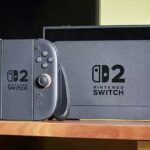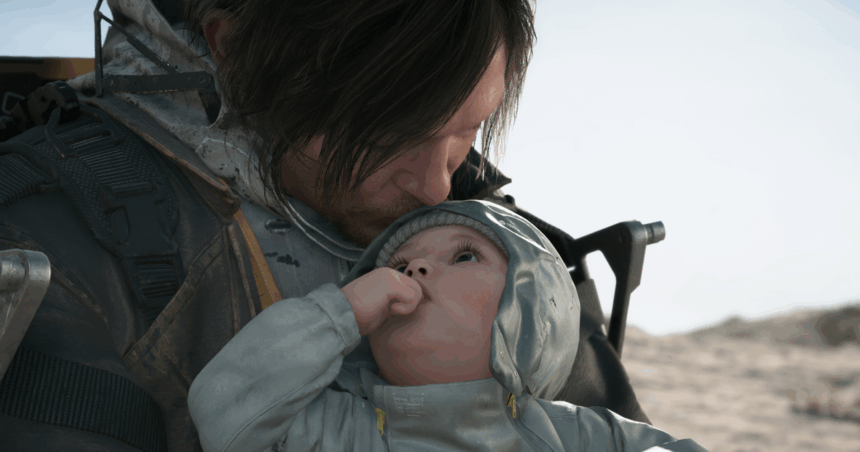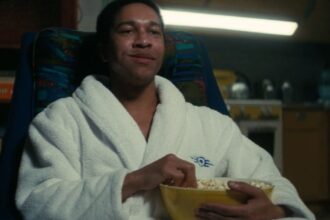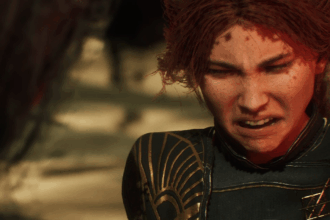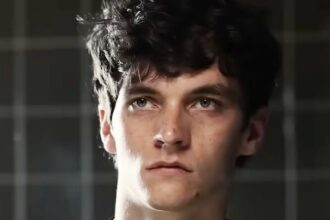Walking into Kojima Productions feels eerie, like stepping into a cinematic universe. The darkened main hallway features bold black walls adorned with striking movie posters for Death Stranding, diverging into paths leading to meeting rooms instead of theaters. On another wall, a tapestry of signed memorabilia and polaroids from notable figures in film, music, and gaming speaks to numerous visitors, almost narrating Hideo Kojima’s creative journey or serving as a unique social media wall.
Kojima’s work has long been intertwined with cinematic elements, especially evident in titles like Metal Gear Solid and Death Stranding. Within the studio, this cinematic influence crystallizes. Alongside gleaming trophy cabinets showcasing his accomplishments, you’ll find a range of professional sound studios, motion capture spaces, and even advanced recording facilities. It’s as if Kojima is orchestrating film and video game production under one roof.
The sci-fi aesthetic permeates the building. The studio is a canvas of monochrome, with sleek black walls and a spotless kitchen area. The standout, however, is the Ludens Room—a dazzling white homage to the studio’s mascot. This room creates an illusion of infinity with mirrored walls and hosts a secret passageway leading to a gallery of Death Stranding artwork, while another portal opens to a circular meeting area that resembles a scene from 2001: A Space Odyssey. One meeting space features an ongoing video feed from the Ludens Room, often catching Kojima overseeing the proceedings—he’s always watching.
I’m here to dive into 30 hours of gameplay for Death Stranding 2, dubbed a “bootcamp” by Kojima himself. Just as the studio mirrors Kojima, so does the game reflect his journey, weaving together elements of his influences, artistry, and personal anxieties about life, death, and human connection.
Exploring the Beach
The first installment of Death Stranding was Kojima unleashed. His earlier career, dominated by the Metal Gear Solid franchise, led to a tumultuous departure from Konami, paving the way for a divisive, innovative experience that was rife with trademark Kojima eccentricities—surreal sci-fi settings, groundbreaking technology, and extravagant cinematic flair.
Players frequently found themselves split; some viewed Death Stranding as a profound reflection on the afterlife and communal bonds, anticipating the Covid-19 pandemic with its contemplative tone. Others dismissed it as a tedious walking simulator burdened with convoluted jargon and monotonous gameplay. However, it undeniably marked a stark departure from Kojima’s Metal Gear Solid roots, alienating some and fascinating others.
One element nearly everyone agrees on is the striking artistry showcased in collaboration with Yoji Shinkawa, the haunting musical score that resonates during pivotal moments, and the innovative use of asynchronous online features.
Now, six years post-pandemic, Kojima is set to release Death Stranding 2: On the Beach. What fresh elements can we expect in this sequel? How has Kojima adapted to criticism? And will the narrative finally coalesce into coherency?
On The Screen
Right from the outset, it’s evident that Kojima has maximized his studio’s impressive resources. The game opens with visuals that impressively transition from cinematic to gameplay seamlessly; the lifelike skin textures on Sam Porter-Bridges are astonishing. As he navigates a desolate landscape, the camera beautifully frames his descent to the backdrop of an emotive score from Woodkid, blending strings with resounding drums. The weather shifts from a stunning sunset to downpour, all performed flawlessly on a base PS5.
Prior to this, players are given the option to review a quick recap of the first game; however, its brief glimpses and voiceover barely scratch the surface of its complexities. This sequel clearly targets those familiar with the original, yet with this narrative groundwork laid, Kojima can shift focus to unfolding a plot that raises lingering questions rather than filling in backstory. The pacing quickens, allowing players to engage in their first significant mission within 20 minutes, with important plot points revealed gradually throughout gameplay.
A notable new feature enhancing the pacing is the Corpus system. Similar to mechanics found in Avowed and Final Fantasy 16, this in-game glossary can be accessed anytime, helping players recap characters and events. Not only is it invaluable, but it also facilitates a more streamlined script, reserving in-depth details for later reference.
The narrative foundation remains comparatively straightforward, at least for now. The 30 hours I’ve played represent roughly 40% of the storyline, but I’ll refrain from spoiling any plot surprises—mostly due to restrictions in place. However, audiences are advised to experience the unfolding story with minimal foreknowledge to fully engage with its eccentricities. Everything I encountered can also be glimpsed in last year’s State of Play trailer. Throughout my experience, intriguing mysteries were abundant, but there’s a lingering concern that the ending could deliver a hefty lore dump reminiscent of the first game.
This sequel unfolds 11 months after the original, with Sam (voiced by Norman Reedus) now in hiding with his BB, Lou. Following the unification of America through the chiral network, delivery tasks have been elevated to the Automated Porter Assistant System (APAS)—effectively sidelining Sam. He has settled into a more tranquil life with his adopted daughter until Fragile (played by Lea Seydoux) emerges, leading a new enterprise called Drawbridge, sending Sam on a mission to connect Mexico to the chiral network. As he crosses the border (yes, there’s a wall), Sam’s journey takes him across the globe—mostly through Australia’s outback.
Even with its clearer storyline, Death Stranding 2 retains the series’ signature weirdness and Koji-style flare—it’s unmistakably a work of Kojima. Sam’s adventure involves shadowy figures from beyond, only visible to half-dead infants; there’s a tar-like flying cat, a woman able to command storms, and a talking puppet which channels a sense of surreal whimsy. One particularly nightmarish sequence featuring fireworks ranks among the most visually stunning set pieces I’ve encountered. Throughout, themes of metaphors and symbolism abound: Sam starts with a cap reading “why me?” and character names like Dollman, Rainy, and Tomorrow leave little to subtlety. Yet, given the groundwork already laid in the first game, Kojima can finally balance out his trademark absurdity with grounded, relatable characters, ensuring that the impressive visuals support emotional believability.
Kojima mentioned during a Q&A that the bond between Sam and Lou is paramount in this sequel. However, broader themes are also at play. “Should we have connected?” asks Kojima in the game’s trailer. I suspect this question won’t be definitively answered until the climax unfolds, but extending the chiral network feels both a means of control and communication. In referencing a visual element of the sequel’s logo, which depicts strands falling from above, Kojima hinted at an element of manipulation akin to puppet mastery. Much of this narrative perspective stems from his personal experiences, reflecting a private contemplation over solitude, loss, and the lasting impact of connections. He aims for players to resonate with thoughts he had during the pandemic: a longing for spontaneous human interactions amidst the backdrop of an all-consuming digital existence.
Gameplay Enhancements
This thematic essence appears to have directly influenced the gameplay of Death Stranding 2. The world is enriched with dynamic elements, offering broader avenues for asynchronous interaction and deeper player expression. The gameplay evolves from the foundational mechanics of the first installment, but the added layers bring greater complexity and nuance. In my time spent, I focused more on engaging with gameplay mechanics than merely attending cutscenes—an undeniable shift from earlier expectations.
The premise remains rooted in cross-country deliveries through perilous terrains, seeking social media recognition while managing loads precariously strapped to Sam’s back and mastering momentum-based movement. Kojima likens the transition from the first to the second game to the evolution seen between Metal Gear Solid 1 and 2—while the first introduced the concepts of stealth gameplay, the second built upon that foundation. In a similar vein, Death Stranding was an initial exploration of delivery concepts, but its sequel expands these mechanisms significantly. To me, it’s reminiscent of the progression from Breath of the Wild to Tears of the Kingdom—familiarity meets depth, enhancing the initial experience.
Let’s discuss environments: the Mexican desert and Australian outback are more vibrant than the previous American landscapes, thanks to variable weather phenomena. Sandstorms toss Sam around, deluges lead to flooding, and seismic tremors can reshape the surroundings, sending debris tumbling. There’s increased diversity in settings, from arid peaks to sun-bleached beaches to lush jungles, all illuminated by either bright sunlight or dramatic moonlight, impacting the temperature of your cargo. Additionally, creating paths through the landscape alerts players to potential hazards, enhancing strategic planning. While I miss the moody, desolate Icelandic tundra that was integral to the last game, it feels relatively static against the vibrant dynamics found here. The shifting landscape and varied light conditions allow Kojima’s cinematographic vision to shine—sunset silhouettes, massive moons, and awe-inspiring landscapes create an atmospheric spectacle.
As the chiral network expands with each mission, the world becomes even more vibrant, filled with signs and structures left behind by other players. Asynchronous online connectivity remains a defining hallmark, with delightful surprises like a perfectly placed ladder from a fellow player enhancing mission experiences. The stakes are raised with added structures, including ziplines that elegantly arc and safehouses serving as checkpoints. My personal favorite is the ramp catapulting Sam through the air with the flair of Sonic the Hedgehog. NPC porters also traverse the landscape, looking for support in the form of a thumbs up. There are still grinding moments of material collection to fully connect the world with roads and now monorails, but aiding other players offers a profound sense of satisfaction. Kojima humorously likens this shared experience to the dynamics of Animal Crossing.
Customization has received a significant boost as well: for Sam, his inventory, and even vehicles. Sam levels up through experience, honing skills like stamina and weapon proficiency. Additionally, as he completes missions, he enhances his porter rank in different regions, unlocking buffs along a skill tree. Greater proficiency in stealth grants perks like improved noise reduction and enemy alerts, while combat experience yields more effective ammunition and scanner capabilities. It’s a sprinkle of RPG elements that fosters an experience tailored to individual playstyles.
Backpack customization allows for the fabrication of various attachments, like extra pouches and shields. This thematic extends to vehicles too. I was able to affix an arm to a truck that automatically retrieved lost packages, while also equipping machine guns for combative forays through enemy installations. Transitioning from slow foot travel to exhilarating vehicle chases was especially cathartic.
While on-foot traversal remains a viable method, the game introduces new equipment and options promptly, urging players to explore varying approaches. Side quests offer enticing rewards too; I snagged some powerful gloves enabling me to directly confront mech adversaries, alongside quirky items like an adorable otter hat for aquatic adventures. While not every moment is frictionless—where’s the excitement in that?—the accumulation of new features means less time stumbling over rocks and more opportunities for creative navigation. The incremental yet meaningful changes altogether lead to a more engaging experience than the first, transforming Death Stranding 2 into an engaging puzzle of traversing its rich landscape rather than just moving between objectives for the next cutscene.
Combat Dynamics
The same can be said for combat. Players have diverse approaches whether facing human adversaries or the notorious BTs: stealth, aggressive shooting, or simply evading encounters are all valid options. The new traversal mechanics make avoidance a real possibility, though you’d miss out on a significant amount of fun.
Death Stranding 2 resembles Metal Gear Solid 6 in many aspects, carrying over the open-world design and stealth-combat fluidity first introduced in Metal Gear Solid V. Mexican and Australian territories are ripe with enemy strongholds, offering Sam the chance to either stealthily eliminate foes or engage in an all-out shootout. The weaponry has broadened, ranging from traditional firearms like pistols and shotguns to unique arthropods along with the return of my beloved rope-firing Bola Gun. The weapon handling feels impactful and combat can be explosive, albeit sometimes overly simple.
Before diving into skirmishes, players can don various camouflage types and hide in carefully placed grass patches (just make sure your pack isn’t too tall!). Throwing tiny puppet Dollman up high allows for enemy reconnaissance similar to Assassin’s Creed mechanics. While Sam may lack the gadgetry of Big Boss, stealthy maneuvers in the jungle under the cover of darkness, eliminating enemies from behind, feel like an audacious response to Konami’s past choices.
Encounters with BTs have grown more dynamic too. Now, previously invisible foes are partially visible, and a new Watcher type can detect Sam’s presence directly rather than through sense. This leads to tense, thrilling stealth segments. With an expanded arsenal ready for retaliation, BT encounters shift from tedious breath-holding exercises to high-stakes shootouts against eldritch horrors. Although the fear factor of BTs seems somewhat diminished, the atmospheric tension remains, especially during rain-soaked skirmishes. I faced off against a couple of surreal bosses, yet I’m still longing for that ultimate Kojima moment akin to Psycho Mantis or The End.
Kojima’s combat philosophy draws indirect influence from Metal Gear, stating, “With so many fans urging me to create another Metal Gear title, I incorporated more combat options.” He expressed concerns during the design phase, as many former Metal Gear staff work alongside him now, leading to conversations about maintaining originality or crossing into familiar territory.
Ultimately, the combination of its futuristic design, audio cues, and open-world stealth structure resonates with Kojima’s legacy. Additionally, there are noteworthy callbacks interspersed throughout—for instance, a character reminiscent of Snake adds an endearing wink to his storied past, while the inclusion of a cyber samurai feels somewhat tired. The new DHV Magellan mobile structure echoes the Metal Gear legacy, albeit with a fast travel feature. Moreover, a limbless character’s reference to “phantom pain” raises eyebrows without the necessary undertone.
I’m torn about these allusions. As a Metal Gear enthusiast, it’s gratifying to witness familiar themes resurging; the refinements to combat in Death Stranding 2 are certainly an upgrade. It feels as if Kojima is directly responding to critiques of the original, eager to please the audience. But, in contrast to the first game’s inventive originality, the sequel’s continual references may seem regressive. Does this suggest Kojima is catering to nostalgia rather than pushing boundaries? What lies ahead for his upcoming espionage venture, Physint?
On the Soundtrack
One of my absolute favorite features in Death Stranding 2 is its inclusive music player. Introduced midway through the game, it allows players to curate playlists from collected tracks, enjoying their tunes anytime while traversing the chiral network. Low Roar’s soundtrack was pivotal in the first title, weaving through iconic moments, yet it’s refreshing to blend the music with player choice as each area opens up. The camera can even be tilted for expansive vistas, making exploration a uniquely personal experience.
While I can’t disclose which artists are on board, there’s a discernible mix following the loss of Low Roar’s lead singer. Woodkid emerges as a prominent figure on the soundtrack, though Kojima conveyed personal concerns of meeting the previous standards. The curation process feels almost like a hobby for Kojima, where he brings in tracks he adores into the game.
The soundtrack thus enhances both gameplay and atmosphere. What it may lack in a unified vision, it compensates with diversity and surprise. Alongside the game’s shift to brighter settings, the music injects a sense of optimism—offering a story more about cherishing life than merely fearing death.
And the music invokes deeply emotional reactions beyond the outlandish sci-fi narratives—something quintessential to Death Stranding. Picture Sam stepping out from a bunker, navigating a lunar-like terrain as bass notes shudder in the background, an ethereal voice gradually crescendoing. As he ascends a ridge, the music peaks, revealing a massive structure looming ahead. Although the location has shifted from Iceland, it still retains those introspective moments after fiery battles that resonate profoundly.
Emerging from Kojima Productions, my mind buzzed with theories and unanswered queries, but my experience with Death Stranding 2 felt inherently more rewarding than its predecessor. It’s more structured, dynamic, and emotionally engaging. Every time I thought I was ready to dismiss its traversal, a fresh upgrade or an intriguing discovery drew me back into the experience. Just when I believed I understood what Death Stranding 2 would offer, it surprised me once again. It feels as though the first game served as a canvas, and its sequel is executing that vision while embracing a hint of Metal Gear—if you’re willing to dive back into Kojima’s mind and suspend disbelief anew.
Death Stranding 2 undoubtedly reflects Kojima’s passion—richly woven gameplay systems, jaw-dropping visuals, and intricate details punctuated with his unique brand of cool. Serving as a window into his post-pandemic reflections, now in his 60s, he grapples with themes of life, death, human connection, legacy, and—most importantly—who the next featured musician will be. It genuinely feels like Kojima’s ultimate opus, encapsulating the essence of his extensive career.
While I’m uncertain why we shouldn’t have connected, I’m certainly thankful for the chance to do so.
This article is based on a press event at Kojima Productions, for which PlayStation assisted with travel and accommodation.


